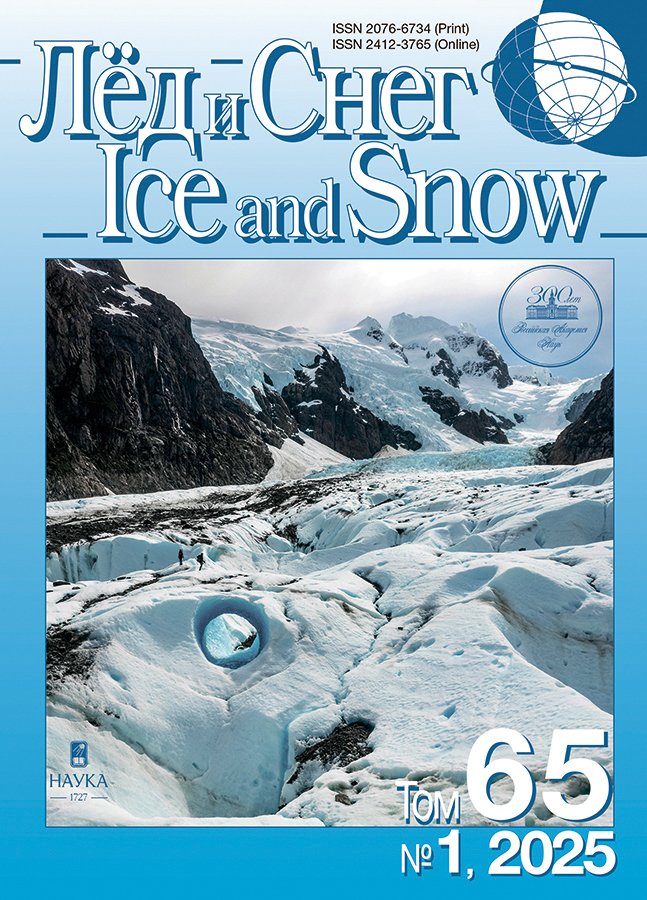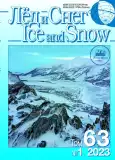Reconstruction of the mean January Air Temperature in the Early Holocene on the Eastern Coast of Chukotka
- Authors: Budantseva N.A.1, Maslakov A.A.1, Vasil’chuk Y.K.1, Vasil’chuk A.C.1, Kuzyakin L.P.1
-
Affiliations:
- Lomonosov Moscow State University
- Issue: Vol 63, No 1 (2023)
- Pages: 93-103
- Section: Palaeoglaciology
- URL: https://journals.rcsi.science/2076-6734/article/view/137477
- DOI: https://doi.org/10.31857/S2076673423010039
- EDN: https://elibrary.ru/HXOPEM
- ID: 137477
Cite item
Full Text
Abstract
The investigation is concerned with the Early Holocene syngenetic massive wedge ice exposed in the outcrop of a polygonal peatland in the upper part of the third marine terrace near Lorino settlement on the eastern coast of Chukotka. Based on the obtained radiocarbon dates of peat, it was found that the formation of a peatland in the area began about 14–13 cal ka BP, at the end of the Younger Dryas, while the termination of the active stage of peat accumulation was dated to about 10–9 cal ka BP. The beginning of peat accumulation at the end of the Younger Dryas, earlier the officially accepted limit of the lower boundary of the Holocene (11.7 cal ka BP), and the termination of its formation by the middle of the Greenlandian Holocene period is not a rare phenomenon in Russian permafrost zone, although it is traditionally assumed that the most active formation of peatlands has been going on during the thermal maximum in the middle of the Holocene. The age inversions noted in the peat vertical profiles are the most likely indicative of the processes of re-deposition of ancient organic material due to erosion by water of the third marine terrace sediments and the separation of the allochthonous peat. During the period from 2015 to 2021, six fragments of peatland exposures with the ice wedges were studied. Analysis of the obtained data on the content of stable oxygen isotopes in the ice show that δ18О values vary within the range from –15.5 to –18‰. These values are in good agreement with the data for Early Holocene ice wedges earlier obtained in other areas of the eastern coast of Chukotka (Anadyr town, Uelen settlement), where authors report the δ18O values from –16 to –19.4‰. This suggests that the ice wedge growth as well as the peat accumulation were the most active in Early Holocene. The highest δ18О values (from –13.1 to –16.8‰) were obtained for the modern ice veinlets. The ratio δ2H–δ18O in the ice wedges, in general, is indicative of a good preservation of isotope signature of winter precipitation. It has been found that approximate mean January air temperature in the Early Greenlandian period varied from –23 to –27°С, which is, on average, 3°С below than the present-day ones.
About the authors
N. A. Budantseva
Lomonosov Moscow State University
Author for correspondence.
Email: nadin.budanceva@mail.ru
Russia, Moscow
A. A. Maslakov
Lomonosov Moscow State University
Email: nadin.budanceva@mail.ru
Russia, Moscow
Yu. K. Vasil’chuk
Lomonosov Moscow State University
Email: nadin.budanceva@mail.ru
Russia, Moscow
A. C. Vasil’chuk
Lomonosov Moscow State University
Email: nadin.budanceva@mail.ru
Russia, Moscow
L. P. Kuzyakin
Lomonosov Moscow State University
Email: nadin.budanceva@mail.ru
Russia, Moscow
References
- Anderson P.M., Lozhkin A.V. Changes in the vegetation and climate of the Northern Okhotsk region at the boundary of the Pleistocene and Holocene. Doklady Akademii Nauk SSSR. Reports of the USSR Academy of Sciences. 1996, 348 (3): 403–406 [In Russian].
- Budantseva N.A., Vasil’chuk Y.K. Winter air temperature in Holocene reconstructed from the ice wedges stable water isotopes near Anadyr town. Led i Sneg. Ice and Snow. 2019, 59 (1): 93–102 [In Russian]. https://doi.org/10.15356/20766734-2019-1-93-102
- Budantseva N.A., Maslakov A.A., Vasil’chuk Yu.K., Baranskaya A.V., Belova N.G., Vasil’chuk A.C., Romanenko F.A. Winter air temperature in the early and middle Holocene on the eastern coast of Daurkin Peninsula, Chukotka, reconstructed from stable isotopes of ice wedges. Led i Sneg. Ice and Snow. 2020, 60 (2): 251–262 [In Russian]. https://doi.org/10.31857/S2076673420020038
- Vasil’chuk Y.K. Oxygen isotope composition of ground ice (application to paleogeocryological reconstructions). Moscow: Theoretical Problems Department Academy of Sciences and Lomonosov Moscow University Publications. 1992, 1: 420, 2: 264 [In Russian].
- Makeev V.M., Arslanov H.A., Baranovskaya O.F., Kosmodamianskij A.V., Ponomareva D.P., Tertychnaya T.V. Stratigraphy, geochronology and paleogeography of the Late Pleistocene and Holocene of Kotelny Island. Byulleten’ Komissii po izucheniyu chetvertichnogo perioda. Bulletin of the Commission for the Study of the Quaternary Period. 1989, 58: 58–69 [In Russian].
- Mikishin Y.A., Gvozdeva I.G., Petrenko T.I. Early Holocene of Sakhalin. Aktual’nye problemy gumanitarnyh i estestvennyh nauk. Actual problems of humanities and natural sciences. 2010, 12: 432–437 [In Russian].
- Neishtadt M.I. On the question of some concepts for the Holocene division. Izvestiya Ros. Akad. Nauk. Seriya geograficheskaya. Proc. of Russian Academy of Sciences. Geographical series. 1983, 2: 103–108 [In Russian].
- Romanenko F.A., Nikolaev V.I., Arkhipov V.V. Changes in the isotopic composition of natural ice on the East Siberian Sea coast: a geographical aspect. Led i Sneg. Ice and Snow. 2011, 1: 93–104 [In Russian].
- Tarasov P.E., Andreev A.A., Romanenko F.A., Sulerzhitsky L.D. Palinostratigraphy of upper quaternary deposits of Sverdrup Island (Kara Sea). Stratigrafiya, geologicheskaya korrelyaciya. Stratigraphy, geological correlation. 1995, 3 (2): 98–104 [In Russian].
- Bronk Ramsey C. Bayesian Analysis of Radiocarbon Dates. Radiocarbon. 2009, 51 (1): 337–360.
- Dansgaard W. Stable isotopes in precipitation. Tellus. 1964, 16: 436–468. doi: 10.1111/j.2153-3490.1964.tb00181.x.
- Lacourse T., Delepine J.M., Hoffman E.H., Mathewes R.W. A 14 000 year vegetation history of a hypermaritime island on the outer Pacific coast of Canada based on fossil pollen, spores and conifer stomata. Quaternary Research. 2012, 78: 572–582.
- Lozhkin A.V., Anderson P.M., Vazhenina L.N. Younger Dryas and Early Holocene Peats from northern Far East Russia. Quaternary International. 2011, 237 (1–2): 54–64. 1 https://doi.org/0.1016/j.quaint.2011.01.009.
- MacDonald G.M., Velichko A.A., Kremenetski C.V., Borisova O.K., Goleva A.A., Andreev A.A, Cwynar L.C., Riding R.T., Forman S.L., Edwards T.W.D., Aravena R., Hammarlund D., Szeicz J.M., Gattaulin V.N. Holocene Treeline History and Climate Change Across Northern Eurasia. Quaternary Research. 2000, 53 (3) 302–311. https://doi.org/10.1006/qres.1999.2123.
- Reimer P.J., Austin W.E.N., Bard E., Bayliss A., Blackwell P.G., Bronk Ramsey C., Butzin M., Cheng H., Edwards R.L., Friedrich M., Grootes P.M., Guilderson T.P., Hajdas I., Heaton T.J., Hogg A.G., Hughen K.A., Kromer B., Manning S.W., Muscheler R., Palmer J.G., Pearson C., van der Plicht J., Reimer R.W., Richards D.A., Scott E.M., Southon J.R., Turney C.S.M., Wacker L., Adolphi F., Büntge U., Capano M., Fahrni S.M., Fogtmann-Schulz A., Friedrich R., Köhler P., Kudsk S., Miyake F., Olsen J., Reinig F., Sakamoto M., Sookdeo A., Talamo S. The IntCal20 Northern Hemisphere radiocarbon age calibration curve (0-55 cal kBP). Radiocarbon. 2020, 62 (4): 725–757. https://doi.org/10.1017/RDC.2020.41.
- Schwamborn G., Meyer H., Fedorov G., Schirrmeister L., Hubberten H. Ground ice and slope sediments archiving late Quaternary paleoenvironment and paleoclimate signals at the margins of El’gygytgyn Impact Crater, NE Siberia. Quaternary Research. 2006, 66: 259–272. https://doi.org/10.1016/j.yqres.2006.06.007.
- Vasil’chuk Y.K. Reconstruction of the palaeoclimate of the Late Pleistocene and Holocene of the basis of isotope studies of subsurface ice and waters of the permafrost zone. Water Resources. 1991, 17 (6): 640–647.
- Vasil’chuk Y.K., Budantseva N.A. Holocene ice wedges of the Kolyma Lowland and January paleotemperature reconstructions based on oxygen isotope records // Permafrost and Periglacial Processes. 2022, 33 (1): 3–17. https://doi.org/10.1002/ppp.2128.
- Vasil’chuk Y.K., Budantseva N.A., Farquharson L., Maslakov A.A., Vasil’chuk A.C., Chizhova J.N. Isotopic evidence for Holocene January air temperature variability on the East Chukotka Peninsula. Permafrost and Periglacial Processes. 2018, 29 (4): 283–297. https://doi.org/10.1002/ppp.1991.
- Vasil’chuk Y.K., Vasil’chuk A.C. Thick polygonal peatlands in continuous permafrost zone of West Siberia. Earth’s Cryosphere. 2016, XX (4): 3–13. https://doi.org/10.21782/KZ1560-7496-2016-4(3-15).
- Vasil’chuk Y.K., Vasil’chuk A.C. Validity of radiocarbon ages of Siberian yedoma. GeoRes. Journal. 2017, 13: 83–95. https://doi.org/10.1016/j.grj.2017.02.004.
- Meteo Publications. Электронный ресурс. http://meteo.ru/data/156-temperature (Last access: 20 September 2022).
Supplementary files














